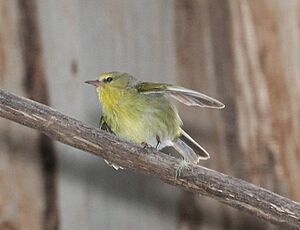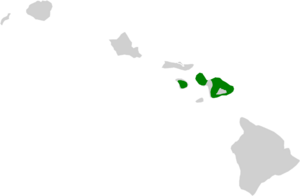Maui ʻalauahio facts for kids
Quick facts for kids Maui ʻAlauahio |
|
|---|---|
 |
|
| Maui ʻalauahio at Haleakalā National Park | |
| Conservation status | |
| Scientific classification | |
| Genus: |
Paroreomyza
|
| Species: |
montana
|
 |
|
| Historic distribution of the Maui ʻalauahio (present range is restricted to east Maui) | |
The Maui ʻalauahio (pronounced ah-lau-AH-hee-oh) is a small, colorful bird found only in Hawaii. It is also known as the Maui Nui ʻalauahio or Maui creeper. This special bird is a type of Hawaiian honeycreeper. It lives only on the islands of Maui Nui, Hawaii.
The name "Maui ʻalauahio" can be a bit confusing. This is because the bird used to live on most, if not all, parts of the ancient Maui Nui. This old landmass included the islands we know today as Maui, Molokaʻi, Lānaʻi, and Kahoʻolawe. There were once two types, or subspecies, of this bird. One was the Lānaʻi ʻalauahio, which lived on Lānaʻi but is now extinct. The other type, P. montana newtoni, still lives on Maui. The common name "Maui ʻalauahio" refers to both of these groups.
Contents
What Does the Maui ʻAlauahio Look Like?
The Maui ʻalauahio looks a lot like another Hawaiian bird, the Hawaiʻi ʻamakihi. They also act in similar ways. However, the Maui ʻalauahio is a brighter yellow color. Its beak is also less curved. It does not have the dark black area between its beak and eye that the Hawaiʻi ʻamakihi has.
Maui ʻAlauahio Sounds
The Maui ʻalauahio makes a loud "cheep" sound. Its song is a repeated whistling sound. It sounds like "whichy-wheesee-whurdy-whew."
What Do Maui ʻAlauahio Eat?
Maui ʻalauahio are insectivores. This means they eat insects. They look for food along tree trunks and branches. They flip over lichen and bark to find insects hiding underneath. Their diet includes moths, beetles, spiders, and other small bugs. They find their food on native Hawaiian plants. These plants include ʻōhiʻa, koa, pilo, and alani trees.
Reproduction and Life Cycle
The Maui ʻalauahio breeding season is from March to August. These birds stay with one partner for life. Sometimes, their older offspring, who are not yet breeding, help at the nest. These "nest helpers" assist the male bird. They help feed the female while she is sitting on the eggs. They also help feed the baby chicks. They usually do this by bringing up food from their own stomachs. Young Maui ʻalauahio birds may stay with their parents for up to 20 months. They then start to breed when they are about three years old.
It is interesting that fewer Maui ʻalauahio pairs have nest helpers in areas where the habitat has been changed by humans. Only 20-30% of pairs in these areas have helpers. But in natural native plant habitats, 96% of pairs have helpers.
Where Do Maui ʻAlauahio Live?
Today, Maui ʻalauahio birds live in only three main areas. These areas are all above 900 meters (about 2,952 feet) high on east Maui. These populations live in different types of habitats. These habitats are protected areas. They include the rainforest of Haleakalā National Park, a tree farm, and a rare dry forest. You can sometimes see Maui ʻalauahio at Hosmer's Grove in Haleakalā National Park. You might also spot them at Polipoli Springs State Recreation Area.
Protecting the Maui ʻAlauahio
The Maui ʻalauahio is an endangered bird. Its living space is shrinking. This is called habitat loss. Many things cause this habitat loss. Wild animals like pigs and goats damage their homes. Also, new plants that are not native to Hawaii, like strawberry guava, grow too much. They take over the space where native plants should be. This makes the habitat less healthy for the birds.
The Maui ʻalauahio also faces another big problem. It is very sensitive to avian malaria. This disease is spread by mosquitoes. If a bird gets bitten by an infected mosquito, there is a 75% chance it will die. This is why the birds are mostly found in higher, cooler places. Mosquitoes that carry malaria do not like to live in these higher elevations.


